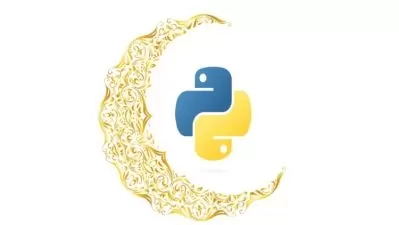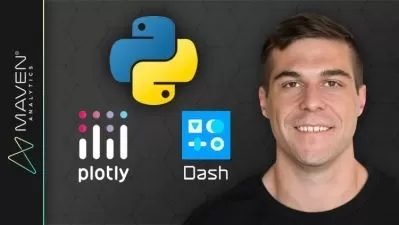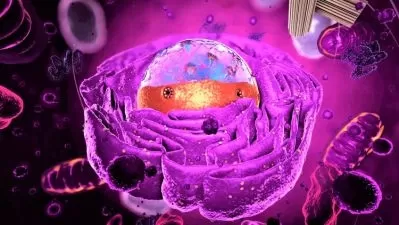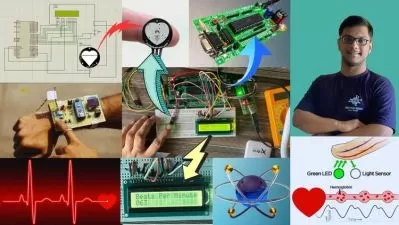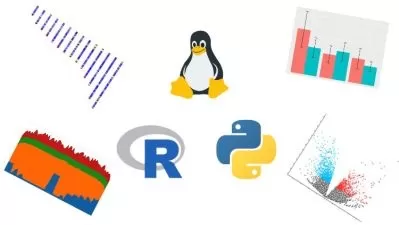Python for Biologists
Ahmed Karam, M.Sc.
9:44:43
Description
Bioinformatics, computational biology, biotechnology, genetics, molecular biology, microbiology, etc. need Python
What You'll Learn?
- The Python syntax
- The data types and conversions
- Performing operations and setting different conditions or questions
- Making decisions and using loops
- The functions and methods that deal with data types
- Opening, creating, reading and writing files
- Working with the operating system
- Handling time and date
- Creating your own functions
- Creating your own modules and scripts
- Creating your own packages
Who is this for?
What You Need to Know?
More details
DescriptionCourse description
This course is designed for beginners in programming with a biological background who want to deal with biotechnology data such as DNA, RNA, and protein, or who want to enter the field of bioinformatics.
This course requires you to install Python (this was explained in detail in the first section), and we will also need to install the Integrated Development Environment in order to write codes in it (this was also explained in the first section).
All the Python files in which the codes were written, which you will see in the videos from the beginning to the end of the course, we have provided in a folder that you will download from the first section of the course.
I want you to read this well because it will explain many things to you that will help you to continue learning the Python language by clarifying the fruit of each section of the course.
In the first section, you will install Python, then you will know the modes through which you can write the codes, then you will learn the basics of the Python language, such as variables and what is related to them, comments, printing data to the user, and receiving data from the user.
From this part, you will be able to learn how to receive data from the user, how to store the data inside the code, and how to output data to the user.
In the second section, you will learn about data types in Python. The meaning of data types in Python is the form in which Python understands user data. And you will learn about converting from one data type to another.
One of the fruits of the first section is storing data in variables. Here you will learn more about the format in which the data will be stored in these variables, and this varies according to the nature of the data that the user will enter. It may be a number, DNA sequence, table, file, and so on.
In the third section, you will learn how to access just one element of data.
After storing the data in a type of Python data, you will be able to delve into the data through Python, so you can access a very small part of the data and thus be able to deal with it however you want.
In the fourth section, you will work with me on simple code. We will rely mostly on the information that we learned in the first three sections, where we will store data in Python, then receive data from the user, then search for it in the stored data, and output information to the user related to the information entered.
In the fifth section, which is extremely important, we will learn operations that can be performed on the entered data and how the data can be updated. We will also put questions or conditions about the data that will give us one of two answers, either true or false.
This section will give you the power to make decisions about the data.
In the sixth section, you will learn how to write your decisions in code and help write procedures based on the decisions made.
This part is very related to the fifth part, so they must be linked together.
In the seventh section, you will learn how to use loops.
These are precisely the ones that a person is unable to perform because they are characterized by repeating a set of commands at the speed of a computer, and therefore they can do complex things that a person cannot do in a short time, and therefore you must understand them well.
In the eighth, ninth, tenth, and eleventh sections, we will learn many functions in Python that manipulate data.
Knowing many functions enables the programmer to manipulate data, which is reflected in the effectiveness of the extracted information.
In the twelfth section, one of the most important sections in the language in general and in the field of bioinformatics in particular, in which you will learn a new method of input and output, where input and output were functions, but now they are files, which are the biological data storage unit.
You will also handle operating system paths within Python.
In the thirteenth section, you will learn how to deal with time and date, and this section may be useful in calculating the time and printing it in the output.
You will find, for example, in some programs that contain more than one process, that the time and date are printed for each process.
In the fourteenth section, you will learn how to separate code and put it into structures that only work by calling, which is building your own functions.
This is the first way to build the code for the user in a usable form.
In the fifteenth section, you will learn to build scripts and modules that are considered the official output from the codes. That is, once you reach this stage, you can create your codes in modules that can be imported into Python easily.
In the sixteenth section, you will learn to build the package, which is a collection of modules.
There will be a project consisting of three modules that will be implemented step by step in front of you, and there will be improvements and error corrections, and therefore you will get good information and experience from this section.
In the end, you will find that the course will teach you information and experiences about how to receive data from the user, how to deal with it, and finally how to output the information that the user wants.
This is what you will need to build your code, whether it will be complete applications or some code that deals with data slightly, or contribute to the use of existing Python packages.
Who this course is for:
- Biologists working with biotechnology data in any discipline.
- Beginners in programming.
- Beginners in Python.
Course description
This course is designed for beginners in programming with a biological background who want to deal with biotechnology data such as DNA, RNA, and protein, or who want to enter the field of bioinformatics.
This course requires you to install Python (this was explained in detail in the first section), and we will also need to install the Integrated Development Environment in order to write codes in it (this was also explained in the first section).
All the Python files in which the codes were written, which you will see in the videos from the beginning to the end of the course, we have provided in a folder that you will download from the first section of the course.
I want you to read this well because it will explain many things to you that will help you to continue learning the Python language by clarifying the fruit of each section of the course.
In the first section, you will install Python, then you will know the modes through which you can write the codes, then you will learn the basics of the Python language, such as variables and what is related to them, comments, printing data to the user, and receiving data from the user.
From this part, you will be able to learn how to receive data from the user, how to store the data inside the code, and how to output data to the user.
In the second section, you will learn about data types in Python. The meaning of data types in Python is the form in which Python understands user data. And you will learn about converting from one data type to another.
One of the fruits of the first section is storing data in variables. Here you will learn more about the format in which the data will be stored in these variables, and this varies according to the nature of the data that the user will enter. It may be a number, DNA sequence, table, file, and so on.
In the third section, you will learn how to access just one element of data.
After storing the data in a type of Python data, you will be able to delve into the data through Python, so you can access a very small part of the data and thus be able to deal with it however you want.
In the fourth section, you will work with me on simple code. We will rely mostly on the information that we learned in the first three sections, where we will store data in Python, then receive data from the user, then search for it in the stored data, and output information to the user related to the information entered.
In the fifth section, which is extremely important, we will learn operations that can be performed on the entered data and how the data can be updated. We will also put questions or conditions about the data that will give us one of two answers, either true or false.
This section will give you the power to make decisions about the data.
In the sixth section, you will learn how to write your decisions in code and help write procedures based on the decisions made.
This part is very related to the fifth part, so they must be linked together.
In the seventh section, you will learn how to use loops.
These are precisely the ones that a person is unable to perform because they are characterized by repeating a set of commands at the speed of a computer, and therefore they can do complex things that a person cannot do in a short time, and therefore you must understand them well.
In the eighth, ninth, tenth, and eleventh sections, we will learn many functions in Python that manipulate data.
Knowing many functions enables the programmer to manipulate data, which is reflected in the effectiveness of the extracted information.
In the twelfth section, one of the most important sections in the language in general and in the field of bioinformatics in particular, in which you will learn a new method of input and output, where input and output were functions, but now they are files, which are the biological data storage unit.
You will also handle operating system paths within Python.
In the thirteenth section, you will learn how to deal with time and date, and this section may be useful in calculating the time and printing it in the output.
You will find, for example, in some programs that contain more than one process, that the time and date are printed for each process.
In the fourteenth section, you will learn how to separate code and put it into structures that only work by calling, which is building your own functions.
This is the first way to build the code for the user in a usable form.
In the fifteenth section, you will learn to build scripts and modules that are considered the official output from the codes. That is, once you reach this stage, you can create your codes in modules that can be imported into Python easily.
In the sixteenth section, you will learn to build the package, which is a collection of modules.
There will be a project consisting of three modules that will be implemented step by step in front of you, and there will be improvements and error corrections, and therefore you will get good information and experience from this section.
In the end, you will find that the course will teach you information and experiences about how to receive data from the user, how to deal with it, and finally how to output the information that the user wants.
This is what you will need to build your code, whether it will be complete applications or some code that deals with data slightly, or contribute to the use of existing Python packages.
Who this course is for:
- Biologists working with biotechnology data in any discipline.
- Beginners in programming.
- Beginners in Python.
User Reviews
Rating
Ahmed Karam, M.Sc.
Instructor's Courses
Udemy
View courses Udemy- language english
- Training sessions 204
- duration 9:44:43
- Release Date 2023/07/22






